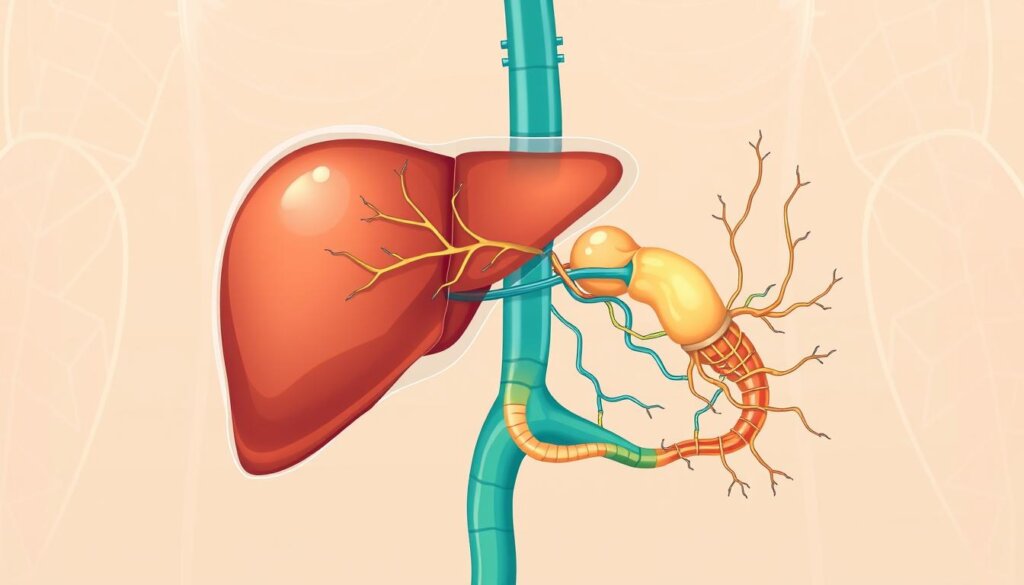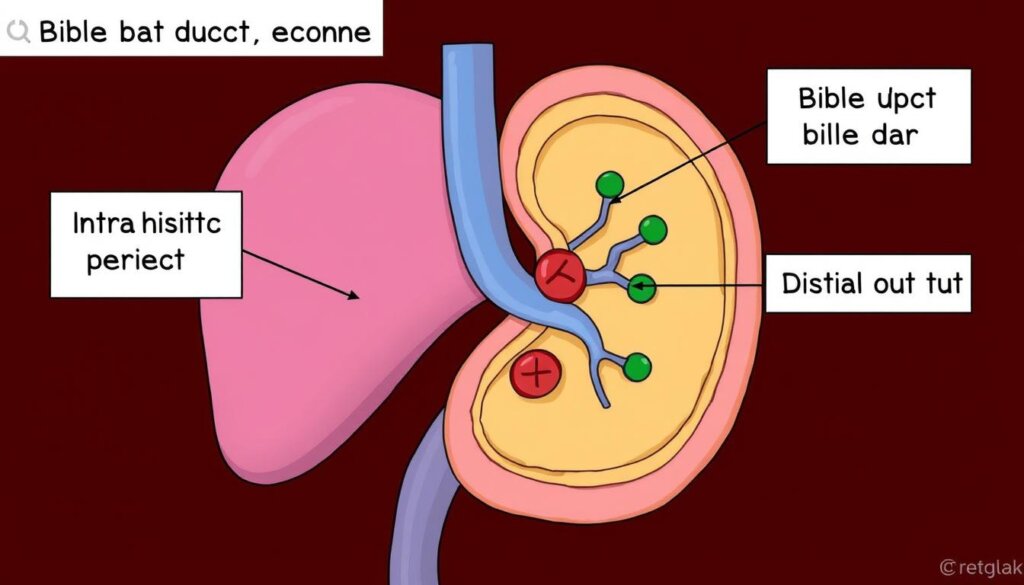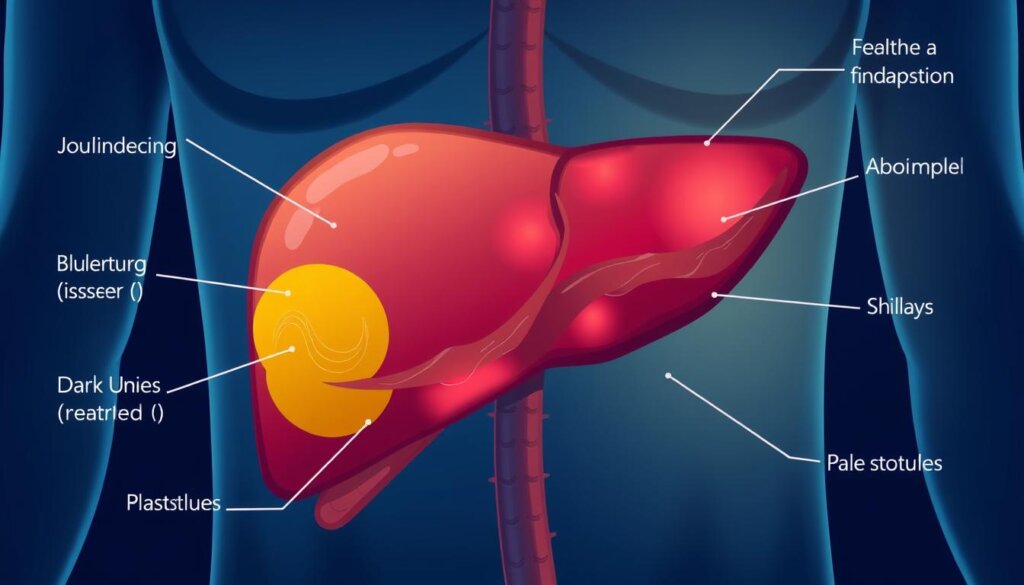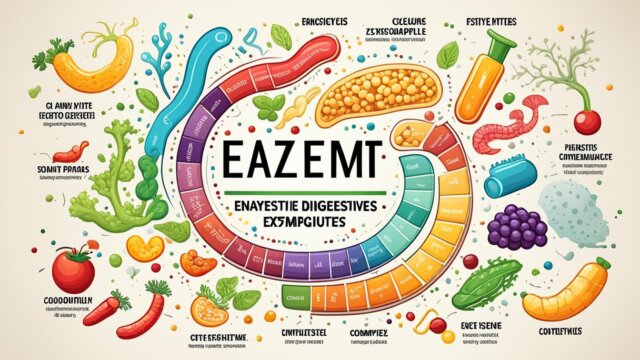FTC disclaimer: This post may contains affiliate links and we will be compensated if you click on a link and make a purchase.
Did you know bile duct cancer, also known as cholangiocarcinoma, is the most common liver cancer? It’s rare but tough to find and treat. Knowing the symptoms, causes, and treatments is key for those worried about bile duct cancer.
Jaundice, or yellow skin and eyes, is the main symptom. It happens when cancer blocks bile ducts, stopping bilirubin from getting to the intestines. Other signs include itching, light-colored or greasy stools, dark urine, and belly pain.
Key Takeaways
- Bile duct cancer is a rare but aggressive form of liver cancer
- Jaundice is the most common symptom, caused by blocked bile ducts
- Other symptoms include itching, light-colored stools, dark urine, and abdominal pain
- Early detection is crucial for improving treatment outcomes
- Moffitt Cancer Center is a renowned center for bile duct cancer diagnosis and treatment
What is Bile Duct Cancer?
Understanding the Biliary System
The biliary system is key to digestion. It’s a network of tubes from the liver to the small intestine. Bile, a yellow-green fluid, flows through these tubes to the gallbladder. There, it waits to help break down fats during digestion.
Bile duct cancer, or cholangiocarcinoma, happens when cancer grows in these tubes. It’s divided into three types: intrahepatic, perihilar, and distal bile duct cancers.
Hepatocellular carcinoma is the most common liver cancer. But, bile duct cancers are mostly cholangiocarcinomas. These start in gland cells lining the ducts. Other rare cancers and benign tumors can also occur in the bile ducts.
Cancers from other parts of the body, like the colon, can spread to the liver. This is called metastasis. Colorectal cancer is an example of this.
Check out the American Cancer Society and the National Cancer Institute to learn more about liver and bile duct cancer. They are great resources.

Bile Duct Cancer Types
Bile duct cancer, also known as cholangiocarcinoma, can be classified into different types. These types are based on where the cancer occurs in the bile ducts. The main types are intrahepatic, hilar, and distal cholangiocarcinoma.
Intrahepatic cholangiocarcinoma forms inside the liver’s bile ducts. This type is rare, with few cases reported. Hilar cholangiocarcinoma, or a Klatskin tumor, happens where the right and left bile ducts meet. Distal cholangiocarcinoma occurs in the bile duct as it goes through the pancreas.
Most bile duct cancers are adenocarcinomas. Other rare types include squamous cell carcinoma, sarcoma, and lymphoma. Non-cancerous tumors like adenomas and hamartomas can also happen.

Knowing the type of bile duct cancer is key for treatment. Accurate diagnosis and staging are crucial for a good care plan.
Symptoms of Bile Duct Cancer
Signs to Watch For
Bile duct cancer may not show symptoms until it’s advanced. Yet, some people might notice signs early. The most common sign is jaundice, which turns the skin and eyes yellow.
Other symptoms include itching, light-colored or greasy stools, and dark urine. You might also feel abdominal pain, unintentional weight loss, fever, nausea, and vomiting. These happen because of a blockage in the bile ducts.
It’s important to remember that these signs can also indicate other health issues. Therefore, it’s vital to see a doctor for a correct diagnosis. Early detection and treatment are key to better outcomes in bile duct cancer.

“Bile duct cancer often doesn’t cause signs or symptoms until later in the disease, but sometimes symptoms can appear sooner.”
Causes and Risk Factors
The exact cause of bile duct cancer is still unknown. But, many risk factors have been found to increase the chance of getting this cancer. These include primary sclerosing cholangitis, a rare liver disease, and chronic liver disease leading to cirrhosis.
Babies born with certain bile duct problems, like choledochal cysts, also face a higher risk.
In Asia, liver fluke infections greatly increase the risk of bile duct cancer. Older age, smoking, diabetes, and some inherited conditions also raise the risk.
Primary sclerosing cholangitis (PSC) is a big risk factor. It’s linked to a high chance of bile duct cancer or cholangiocarcinoma. Studies show up to 50% of people with PSC may get bile duct cancer.
A UK study found an incidence of 1.3 per 100,000 person-years.
Liver flukes are a big problem in Asia, making bile duct cancer more common. Exposure to chemicals like thorotrast also raises the risk of bile duct cancer.
While liver cirrhosis, hepatitis B or C, obesity, diabetes, alcohol, and smoking may play a role, the evidence is not as strong.

Knowing the risk factors for bile duct cancer is key for early detection and prevention. Being aware of these factors helps individuals monitor their health and seek medical help if needed.
Risk Factor | Increased Risk |
|---|---|
Primary sclerosing cholangitis (PSC) | Up to 50% lifetime risk of bile duct cancer |
Chronic liver disease/cirrhosis | Increased risk |
Bile duct abnormalities (e.g., choledochal cysts) | Increased risk |
Liver fluke infections (in Asia) | Much higher risk |
Older age | Higher risk in 60s and 70s |
Smoking | Increased risk |
Diabetes | Increased risk |
Inherited genetic conditions | Increased risk |
By knowing the risk factors for bile duct cancer, people can take steps to stay healthy. They should watch for symptoms and get medical help if needed.
Bile Duct Cancer Diagnosis
Diagnosing bile duct cancer needs many tests and steps. First, blood tests check for tumor markers like Carcinoembryonic antigen (CEA) and CA 19-9. These markers show if bile duct cancer is present.
Then, doctors use imaging scans like ultrasound, CT scans, MRIs, and MRCP. These scans give clear pictures of the bile ducts and nearby organs, helping them find and understand the cancer’s stage.
At times, doctors need to perform more detailed tests. ERCP (Endoscopic Retrograde Cholangiopancreatography) and PTC (Percutaneous Transhepatic Cholangiography) allow them to see the bile ducts up close. They might also take tissue samples for biopsy.
The cancer’s location, stage, and if it can be removed by surgery affect treatment. Other conditions like primary sclerosing cholangitis also play a role.
Unfortunately, bile duct cancer is often found late. This makes surgery hard. Then, doctors might use palliative therapy to ease symptoms and improve life quality.
Early detection is key to managing bile duct cancer well. It boosts treatment chances and outcomes. Knowing about these diagnostic steps helps people work with their doctors for early and accurate diagnosis.
Treatment Options for Bile Duct Cancer
Surgical and Non-Surgical Approaches
The treatment for bile duct cancer varies based on the tumor’s stage and location. If the cancer hasn’t spread, removing the affected bile duct might be an option. This is seen as the only way to possibly cure bile duct cancer. Yet, most bile duct cancers are too far along when found.
Other methods are used for more advanced or untreatable tumors. Chemotherapy aims to kill cancer cells, and it’s often given before a liver transplant or for advanced cholangiocarcinoma. Radiation therapy is also used to kill cancer cells, using either external beam radiation or internal brachytherapy. Liver transplantation is sometimes considered for tumors that can’t be removed, but finding a donor is hard.
Other options for untreatable bile duct cancers include targeted therapy, immunotherapy, ablation techniques, and clinical trials. Keeping quality of life high is key, with palliative care helping manage symptoms.
Treatment Approach | Applicability |
|---|---|
Surgical Resection | For early-stage, resectable bile duct cancers |
Chemotherapy | For advanced, unresectable bile duct cancers |
Radiation Therapy | For unresectable bile duct cancers, either alone or in combination with chemotherapy |
Liver Transplant | For some unresectable intrahepatic or perihilar bile duct cancers |
The aim of treating bile duct cancer is to improve patients’ quality of life. This can be through surgery, palliative care, or clinical trials.
Prevention and Risk Reduction
There’s no guaranteed way to avoid bile duct cancer. But you can take steps to lower your risk. Quitting stop smoking is key, as smoking raises your cancer risk. Also, managing liver diseases and cutting down on alcohol can help.
Seeing your doctor regularly is vital. They can spot bile duct cancer early, which is key for treatment. Getting the Hepatitis B vaccine and treating chronic Hepatitis B can also lower your risk.
- Quit smoking to reduce your risk of bile duct cancer
- Manage any underlying liver diseases to lower your chances of developing this type of cancer
- Reduce alcohol intake to further decrease your risk
- Undergo regular check-ups with your doctor for early detection
- Consider the Hepatitis B vaccine and treatment for chronic Hepatitis B infection to prevent bile duct cancer
By taking these steps, you can lower your risk of bile duct cancer. This helps keep you healthy and well.
Bile Duct Cancer: Early Detection is Crucial
Early detection is key for treating bile duct cancer well. Sadly, this cancer is often found late, making treatment harder. Early tumors don’t show symptoms, making them hard to find during check-ups.
It’s very important to see a doctor right away if you notice any strange signs. Signs like jaundice, pain, or losing weight without reason need quick doctor visits. Finding cancer early can greatly improve your chances of survival.
Scientists are working hard to find better ways to screen for bile duct cancer. Right now, there’s no blood test for early detection, but doctors use many tools, such as medical history and imaging, to find problems early.
At the Moffitt Cancer Center, experts focus on bile duct cancer. They aim to improve screening and care, stressing the need for early detection for better outcomes.
“Early detection is crucial for the best possible outcome in bile duct cancer cases.” –
Being alert and seeing a doctor fast can help you find bile duct cancer early. This is when treatment works best, and survival chances are higher.
Statistic | Value |
|---|---|
Incidence of early bile duct cancer in study group | Higher |
Chance of survival for bile duct carcinoma patients | 18% |
Prognostic determinants in extrahepatic bile duct cancer | Analyzed |
Incidence of primary liver cancer in Koreans | Estimated |
Cases of primary sclerosing cholangitis analyzed | 28 |
Serum levels of tumor marker CA19-9 in acute cholangitis | Elevated |
Cholangioscopic characterization of dominant bile duct stenoses | Achieved |
Comparison of cytology and FISH for malignant bile duct strictures | FISH showed promising results |
Guidelines for cholangiocarcinoma diagnosis and treatment | Established |
Survival rates in resected biliary malignancies | Improved |
Bile Duct Cancer: Prognosis and Survival Rates
Knowing about the prognosis and survival rates for bile duct cancer is key. The outlook depends on the cancer’s stage and how well it responds to treatment. If caught early and removed by surgery, the five-year survival rate is about 30%.
But most bile duct cancers are found later when the survival rate drops to 5-10%. The cancer’s location, if it has spread, and the patient’s health also matter. New research and treatments offer hope for better outcomes.
The latest data shows a 1-year survival rate of almost 30% for bile duct cancer patients in England from 2017 to 2019. But the 5-year survival rate for those diagnosed from 2014 to 2016 was only 5%. Early detection and effective treatment are crucial.
Bile duct cancer is aggressive and rare, with about 8,000 new cases in the U.S. each year. The five-year relative survival rate is 9% for intrahepatic and 10% for extrahepatic bile duct cancer. The prognosis depends on the cancer’s stage at diagnosis.
- Localized intrahepatic bile duct cancers (stages 0 and 1) have a five-year relative survival rate of 24%.
- Distant intrahepatic bile duct cancers (stage 4B) have a five-year relative survival rate of only 2%.
- Localized extrahepatic bile duct cancers have a 17% relative survival rate, while distant extrahepatic bile duct cancers have a 2% five-year relative survival rate.
The prognosis for bile duct cancer varies a lot. Factors like age, health, and treatment response greatly affect the outcome. Despite its challenges, medical care and research offer hope for patients and their families.
“Bile duct cancer is a rare and serious form of liver cancer that can be difficult to treat, but ongoing research and advancements in therapy are providing new hope for improving outcomes for those diagnosed with this disease.”
Conclusion
Bile duct cancer is a tough form of liver cancer. We need to be careful and get medical help early. Knowing the signs, risks, and treatments can help a lot.
By spreading the word and focusing on early detection, we can help people watch their health. This can lead to better treatments and a better life for those with this disease.
Combining efforts from doctors, researchers, and everyone else is key to understanding bile duct cancer better. This will allow us to find treatments sooner and help patients and their families more.
FAQ
What is bile duct cancer?
Bile duct cancer, also known as cholangiocarcinoma, is a rare cancer. It forms in the bile ducts. These ducts carry digestive fluid from the liver to the gallbladder and small intestine.
What are the different types of bile duct cancer?
Doctors classify bile duct cancer by where it starts. Intrahepatic cholangiocarcinoma is in the liver. Hilar cholangiocarcinoma is just outside the liver. Distal cholangiocarcinoma is near the small intestine.
What are the common symptoms of bile duct cancer?
Jaundice, or yellow skin and eyes, is a common symptom. It’s caused by too much bilirubin. Other signs include itching, light-colored stools, dark urine, and abdominal pain.
Unintentional weight loss, fever, and nausea or vomiting can also occur.
What are the risk factors for bile duct cancer?
Risk factors include primary sclerosing cholangitis and chronic liver disease. Liver fluke infections and certain genetic conditions are also risks. Smoking, diabetes, and older age increase risk too.
How is bile duct cancer diagnosed?
Diagnosing bile duct cancer is hard and may need many tests. Blood tests, imaging scans, and procedures like ERCP or PTC are used. A biopsy confirms the diagnosis.
What are the treatment options for bile duct cancer?
Treatment depends on the tumor’s stage and location. Surgery may be an option if the cancer is early. For more advanced cases, chemotherapy, radiation, or liver transplant may be considered.
How can I reduce my risk of developing bile duct cancer?
Quitting smoking and managing liver diseases can help. Drinking less alcohol and regular doctor visits are also important. These steps can lower your risk.
What is the prognosis and survival rate for bile duct cancer?
Survival rates vary based on diagnosis timing and treatment response. Early detection offers a 30% five-year survival rate. But, for late-stage cancer, it’s only 5-10%.








